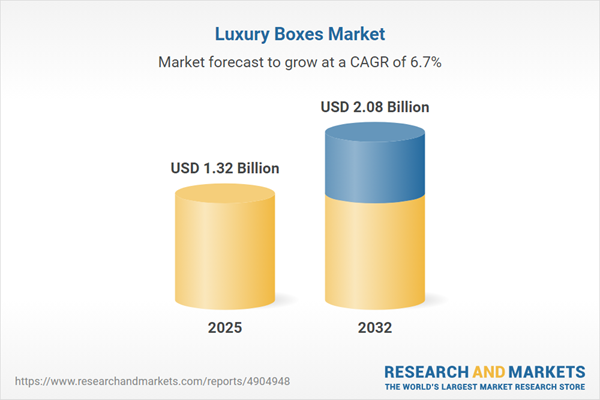Speak directly to the analyst to clarify any post sales queries you may have.
The luxury boxes market is witnessing rapid transformation, driven by evolving brand expectations, consumer preferences for sustainability, and increased demand for personalized packaging. As luxury boxes shift from simple containers to experience-enhancing assets, leading companies and new entrants are recalibrating strategies to align with dynamic global and sector trends.
Market Snapshot: Luxury Boxes Market Growth and Momentum
Building on consistent year-over-year growth, the luxury boxes market advanced from USD 1.24 billion in 2024 to USD 1.32 billion in 2025. The market is projected to sustain a compound annual growth rate of 6.66%, reaching USD 2.08 billion by 2032. Robust expansion is underpinned by premiumization trends, greater consumer focus on brand experience, and innovations in packaging formats and materials. Senior stakeholders are recognizing luxury boxes as vital tools for elevating product value, engaging customers, and differentiating in crowded markets.
Scope & Segmentation
This comprehensive report analyzes the luxury boxes market across material categories, packaging formats, application industries, sales channels, and price ranges. Regional analysis covers established and growth geographies with full value-chain perspectives.
- Material Types: Metal (aluminum, steel, tinplate), Paperboard (coated recycled board, folding box board, solid bleached sulfate), Plastic (PET, PP, PVC), Wood (bamboo, plywood)
- Packaging Formats: Composite cans (with metal or plastic lids), Folding cartons (corrugated, standard), Rigid boxes (one-piece tuck top, two-piece setup), Sleeve packaging (full and partial sleeve)
- End Use Industries: Cosmetics & personal care, Electronics, Food & beverage (bakery, confectionery, dairy), Luxury goods (jewelry, watches), Pharmaceutical
- Distribution Channels: Department stores, Direct sales, Online retailers, Specialty stores, Supermarkets and hypermarkets
- Price Ranges: Economy, Standard, Premium
- Regions: Americas (North America, Latin America), Europe, Middle East & Africa, Asia-Pacific
- Market Participants: Amcor plc, Smurfit Kappa Group plc, Mondi plc, DS Smith plc, International Paper Company, Berry Global Inc., Packaging Corporation of America, Sealed Air Corporation, AptarGroup, Inc., WestRock Company
Key Takeaways
- Luxury packaging plays a pivotal role in reinforcing brand narratives and deepening consumer engagement, especially for premium segments.
- Sustainability and personalization now drive innovation, with brands favoring eco-friendly material blends and tailored packaging designs.
- Digital printing and smart packaging solutions offer greater flexibility and customer interaction, expanding opportunities for targeted retail and post-purchase engagement.
- Collaborative supply chains have become vital as brands and converters mitigate challenges related to resource availability and maintain traceability.
- Distribution via direct sales and specialty retailers enables high customization, while e-commerce growth accelerates demand for protective, visually compelling solutions.
- Integration of new manufacturing technologies and closed-loop recycling enhances operational resilience and aligns with regulatory shifts across global markets.
Tariff Impact on Materials Sourcing and Strategy
Newly enacted tariffs on materials such as aluminum, steel, tinplate, and high-grade paperboard have elevated cost structures for luxury box manufacturers. These measures are reshaping procurement models, with industry players increasingly pursuing domestic sourcing, risk-sharing contracts, and accelerated material substitution programs to protect design integrity and profitability. Strategic adaptation is paramount to respond to tightened supply channels and shifting trade policies.
Methodology & Data Sources
This report applies integrated research, combining secondary sources like industry publications and regulatory filings with primary interviews and site visits. Data verification utilizes trend mapping, scenario modeling, and cross-validation with an advisory panel of industry experts for practical applicability.
Why This Report Matters
- Equips leaders with actionable insights to guide investment, procurement, and innovation decisions for greater market impact.
- Enables identification of emerging growth segments and technologies, supporting competitive positioning in fast-evolving regions.
- Offers clarity on regulatory and trade developments, allowing organizations to proactively adjust risk management and supply chain strategies.
Conclusion
The luxury boxes market is advancing through design, sustainability, and digital integration. Informed decisions guided by this report will help stakeholders anticipate challenges, capitalize on opportunities, and maintain a leading position in this sophisticated marketplace.
Additional Product Information:
- Purchase of this report includes 1 year online access with quarterly updates.
- This report can be updated on request. Please contact our Customer Experience team using the Ask a Question widget on our website.
Table of Contents
3. Executive Summary
4. Market Overview
7. Cumulative Impact of Artificial Intelligence 2025
Companies Mentioned
The companies profiled in this Luxury Boxes market report include:- Amcor plc
- Smurfit Kappa Group plc
- Mondi plc
- DS Smith plc
- International Paper Company
- Berry Global Inc.
- Packaging Corporation of America
- Sealed Air Corporation
- AptarGroup, Inc.
- WestRock Company
Table Information
| Report Attribute | Details |
|---|---|
| No. of Pages | 199 |
| Published | November 2025 |
| Forecast Period | 2025 - 2032 |
| Estimated Market Value ( USD | $ 1.32 Billion |
| Forecasted Market Value ( USD | $ 2.08 Billion |
| Compound Annual Growth Rate | 6.6% |
| Regions Covered | Global |
| No. of Companies Mentioned | 11 |









